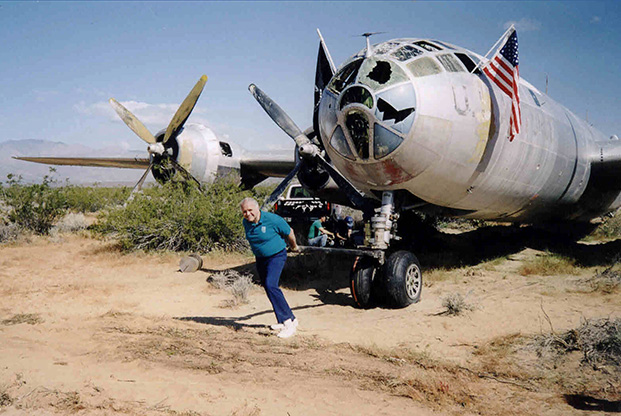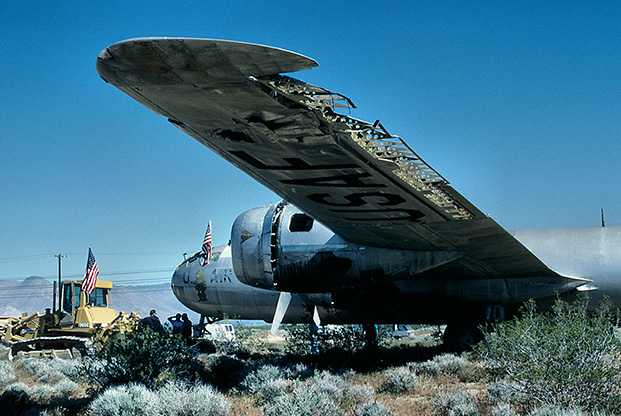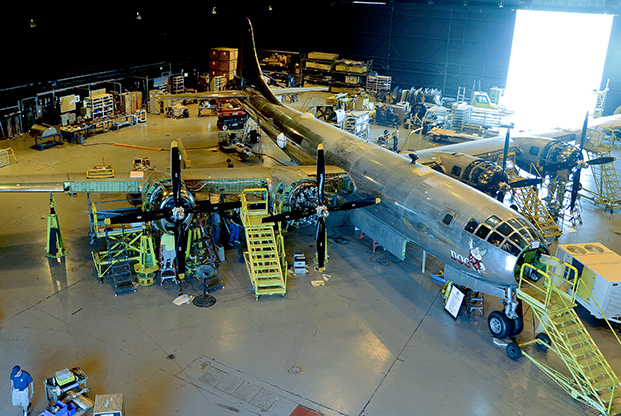
Tony Mazzolini and Doc at the Navy’s China Lake boneyard in California, as the venerable bomber is removed from the target range. Photo: Dan Wimberly/Doc’s Friends Inc.
In the skies over Oshkosh, Wis., in July of 2017, two World War II-era B-29 Superfortress bombers joined formation for the first time in six decades. It was an improbable tableau that many thought would never take place. That historic formation was as much about perseverance as it was about the changing landscape of warbird restorations.
The historical aircraft community celebrated when the then-Confederate Air Force (CAF) resurrected a B-29 Superfortress from a Mojave Desert boneyard at the Navy’s China Lake Naval Weapons Center in California in 1971 and flew it to Texas to begin a long second career as a flying legend. At least three other B-29s made some flights in the 1970s and 1980s before retiring to museums, but the longevity of the CAF B-29, nicknamed FIFI made it the only flying Superfortress in the world.
Until Doc entered the skies, that is. Doc is another China Lake survivor, part of a gaggle of B-29s that made one-way flights to the Navy test facility in the mid-1950s to serve as ground targets to help testers measure the efficacy of new ordnance.
Doc and FIFI were refurbished in different locations and different decades with different sponsors. What made both of these B-29 resurrections possible was the tenacity of a patron and steward with the vision to look beyond sandblown B-29 hulks in the Mojave Desert and into the future.
Victor Neils Agather was that sparkplug for FIFI. A World War II veteran who worked on developing and perfecting the B-29, Agather enjoyed postwar success as an international business leader. When the CAF was able to secure one of the desert B-29s at China Lake, advocate Agather pitched in more than $100,000 to make it possible to ferry the bomber from China Lake to the CAF’s home, which in 1971 was Harlingen, in south Texas. Agather clearly had skin in the game.
Naming the B-29 FIFI was a tip of the hat to Agather’s wife. Her namesake bomber continues to fly.

Doc, showing its age, is towed out of the desert at China Lake. Photo: Dan Wimberly/Doc’s Friends Inc.
IT WAS JUST THE BEGINNING
Tony Mazzolini was the indefatigable visionary for Doc. After Air Force service in the 1950s, Mazzolini’s managerial acumen served him well in positions with General Electric and Continental Airlines. Mazzolini had a bit of a soft spot for the B-29 Superfortress. He remembered encountering a special Air Force radar squadron with nine B-29s nicknamed for Snow White, the Seven Dwarfs, and the wicked witch who plagued them. Each of the bombers carried the likeness of one of the characters in that story. In the last half of the 1980s he pondered the possibility of finding a second B-29 to restore to flightworthiness to complement FIFI. The prospect was at once intriguing and improbable.
Soon he was the tip of the spear for this quixotic notion. He had heard stories about more than 200 of the big Superfortresses making their last flights to the Aberdeen Proving Ground and China Lake Naval Weapons Center for use as test targets.
His early inquiries to the Navy at China Lake were met with replies that would discourage someone with lesser determination. No, he was told, the China Lake Superforts were all gone. Finding that hard to accept, Mazzolini kept at it until his perseverance was rewarded with the confirmation that one China Lake B-29 remained, isolated on a distant bombing range in the desert. Mazzolini’s Herculean labors were only beginning.
Mazzolini finally received permission to visit the range in 1987. As the truck carrying the inspection party rumbled over worn desert ruts, he could see a largely intact Superfortress looming in the distance. This was ample validation for Mazzolini, who almost leaped from the truck as it was still moving in on the bomber, so eager was he to inspect the aircraft.
His joy at once again beholding a Superfortress was multiplied when the identity of this airframe—Air Force serial number 44-69972—turned out to be Doc, one of the named B-29s he had encountered so many years earlier at Griffiss AFB, N.Y.
The Navy was initially reluctant to sign over an essentially intact Superfortress, no matter how outdated its technologies, to Mazzolini four decades after the B-29 was built. The bomber would have to be demilitarized to render it unflyable, Mazzolini was told in early discussions. He went through the proper steps, creating a nonprofit 501(c)(3) organization to help support his endeavor to acquire the B-29. Negotiations to get the Navy to release the desert B-29 without demilitarizing it moved at a glacial pace.
Back in 1987, little did he know it would take more than 11 years before he could lay claim to the B-29 called Doc.

Doc and restoration volunteers in the repair bay at the Wichita, Kan., facility in 2014. Photo: A1C John Linzmeier
QUID PRO QUO
In the 1980s, branches of the military occasionally dipped into surplus aircraft resources to trade for historic aircraft needed by the services’ museums. The Navy’s quid pro quo for Doc seemed straightforward enough; the historical Naval aviation collection in Pensacola, Fla., needed a B-25 Mitchell twin-engine bomber in restored condition. If Mazzolini would furnish that, the Navy would release Doc.
By that time, B-25s were enjoying a renaissance of interest in the American warbird community, fueled in part by the massive collection of 18 of the bombers resurrected by Tallmantz Aviation for the movie “Catch-22” years earlier. The American countryside was not littered with unwanted B-25s.
Mazzolini finally located an available Mitchell airframe in Venezuela at a price he could live with, had it dismantled and shipped to Florida, and then moved by rail to Cleveland for static restoration.
What Mazzolini charted as a six-month refurbishment program on the Mitchell stretched into a six-year effort.
First, restorers lost access to the building in Cleveland and the bomber had to be bundled up and shipped to Pennsylvania, where the Air Heritage Museum completed the restoration.
Then the Navy—initially requesting to have the Mitchell restored and configured as a representation of one of Doolittle’s Raiders—changed their mind and requested that it be finished as a naval PBJ variant. Mazzolini obliged.
Meanwhile, the lone Superfortress in the desert, although earmarked for Mazzolini, was occasionally the object of unwanted suitors. He had to keep an eye on his prize to make sure interlopers did not get it before he could complete the deal.
By 1998 all was in order. The Mitchell bomber was restored for the Navy, and Doc was released intact to Mazzolini, its title transferred to enable the bomber’s extraction from the desert range to be readied for restoration. Fresh tires put Doc in position to roll as the bomber was gingerly towed miles from its range location to the civilian airport at Inyokern, Calif.

Doc gleams on the flight line at McConnell AFB. Photo: SSgt. Rachel Waller
RESTORATION
Mazzolini and his small crew savored the idea of preparing their B-29 for its first flight in decades from Inyokern, back to a more populous aviation center where further restoration would be accomplished. After all, hadn’t three other China Lake B-29s left the desert under their own power? The dry desert generally favored the preservation of aluminum airframe structure, even as the relentless sun made the replacement of soft parts —rubber, fabric, and plastics—mandatory.
But decades had elapsed since the last B-29 flew from China Lake. And there’s a big difference between abandoning an aircraft and storing it properly for possible reuse at a site like the Aerospace Maintenance and Regeneration Group (AMARG) at Davis-Monthan AFB, Ariz. At AMARG, experience and experiments in preservation have led to ways of minimizing intrusion of the elements into the vitals of stored aircraft. Not so on the China Lake range; no such requirement was anticipated when Doc was towed out to the desert.
Tony’s crew at Inyokern perceived a confluence of problems as they looked into their Superfortress on the open-air ramp. Volunteers, in adequate numbers and with desirable skills, were harder to find than they would be in an aviation metropolis. And Doc, unprepared for long-term exposure to the elements, had aluminum corrosion requiring remediation beyond what the available crew could prudently accomplish on the windswept tarmac at Inyokern.
It was another setback—but not a showstopper. Mazzolini had asked Boeing’s specialists on aging aircraft to conduct a structural inspection on the B-29. If Doc could not fly out from Inyokern, it could truck out. He called Boeing’s Wichita plant, where Doc had first seen the light of day in 1945 and where Boeing had ongoing aircraft construction programs at that time.
Jeff Turner, then a Boeing vice president in Wichita, green-lighted the plan to truck Doc back to its home plant for repair and restoration by volunteers.
There’s an elite corps of big rig truckers who specialize in relocating aircraft for museums. How do you move a B-29 Superfortress over the road? In many sections, separated with care, to enable them to be rejoined later. Another two years had elapsed; it was now 2000 and Doc needed to relocate.
ON THE MOVE
Tony called Ben Nattrass, whose Worldwide Aircraft Recovery company has carefully dismantled and trucked dozens of aircraft, including outsized Boeing behemoths like B-29s, B-50s, and KC-97s, which bear some fundamental structural similarities to Doc.
Nattrass knows how to study an airframe and disassemble it in ways that will make reconstituting the pieces as a whole aircraft feasible and without scarring. This is especially important for an artifact like Doc, intended to fly again.
“B-50s and KC-97s have a five-piece wing and the inner panels come off the sides of the fuselage,” Nattrass explains. Some B-29s had a five-piece wing, others a four-piece wing that carried through the fuselage, technically joined in the middle of the fuselage, but a monster to disassemble. “Doc had the four-piece wing,” he said.
“Two outer wing panels and two inner wing panels that split in the center. There is a top fuselage cap that is removed, and the wing is lifted out the top of the fuselage. Because Doc was going to fly, we did not split the inner wing and we transported it as a complete 99-foot-long load,” Nattrass continued.
That B-29 bullet fuselage is just a foot shy of 100 feet from nose to tail gun position. Nattrass had moved B-29s before, and he knew just what to do: “A production split just behind the wing breaks the fuselage into two transportable pieces,” he recounted.
If that was straightforward for experienced aircraft truckers—it still wasn’t easy. Cranes needed to be scheduled onsite at Inyokern. Cribbing and jigging had to be finessed to support the precious bomber without imparting damage to its structure during the almost 1,500-mile journey over the road to Wichita in seven truckloads.
What showed up at the Wichita gates in May 2000 is a matter of opinion. Mazzolini saw his dream B-29; others saw trailer loads of derelict bomber bones, filled with vestiges of desert sand and the desiccated remains of a few critters who sought refuge in the aircraft to no avail.
Dan Wimberly was one of the Boeing craftsmen who saw the trailers carrying Mazzolini’s hopes and dreams. He remembers Doc’s first impression: “It was in sections and pieces on seven semi-truck flatbeds. It was rolled in ceremonial fashion … like a war hero returning from the front line battlefield. The piles of broken wires, tubing, glass shattered or missing altogether was quite a discouraging sight!”
The broken glass, dirt, and detritus in the B-29 was a far cry from the pristine 737 fuselages he helps to craft on a daily basis. “I’m not touching it,” Wimberly decided. A toolmaker, Wimberly had a skill set the B-29 restorers needed. He made a special tool at the request of the bomber team, and soon “I was hooked,” he admitted.
Not surprisingly, the initial rush of volunteers to work on Doc’s restoration gave way to a smaller core, Wimberly remembers, as the “not really what I had in mind” people left the effort.
Volunteers ranged from retirees who probably drove rivets on Doc in 1945 to current aerospace employees, to some supporters who brought more enthusiasm than experience. The team leaders managed to meld this varied crew into a workable force for restoration of the 37-ton bomber entrusted to their care.
If the overall restoration of Doc looked daunting back then, the Gordian knot was the corrosion discovered at Inyokern. Ultimately, the wing’s lower right spar, an inverted T-section 27 feet long, had to be replaced with new metal. Nobody had manufactured a B-29 wing spar in many decades. With copies of wartime Superfortress blueprints, a new piece was crafted, but not without some learning-curve issues along the way.
WORTH THE WAIT
Wimberly remembers the outcome: “About eight years into the restoration project, we reinstalled the center wing section into the fuselage. I still remember the roar of cheers and applause from those gathered when we drove home the final wing bolt pins.”
Five years into the B-29 restoration, Boeing sold off its Wichita manufacturing operations. Spirit AeroSystems became the new vendor of fuselages and structures for a number of Boeing aircraft, and now Spirit was the landlord for Doc’s shop space. Spirit management, peopled by many of the former Boeing regulars including Jeff Turner, embraced Doc’s restoration.
During the 16-year restoration, occasionally new materials and methods were better than old ones, and all of this was folded into Doc’s dossier to facilitate the path to FAA airworthiness certification. State-of-the-art processes, including computerized design and machining, left no room for shade-tree mechanics.
Doc’s rebirth as a pristine flying machine is emblematic of the evolving warbird movement around the world. Decades ago, a sole owner/operator might restore and fly a P-51 or similar project, but a bomber as big as a B-29 was too much for most individuals or groups to contemplate. But advances in computer capabilities have meshed with an increased sense of pride and urgency about restoring the famed aircraft of World War II, leading to evermore ambitious restorations that would have been dismissed as too audacious years ago.
And now there are two flying B-29 Superfortresses in the world. Even as they bear witness to the wartime generation who originally animated them, these mechanical marvels both tell another story of determination and optimism that is the very reason they still exist at all.